Front Row Seat on a Hidden Universe: A Conversation with Torsten Wittmann
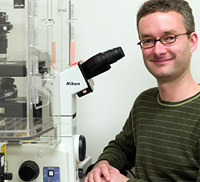
Torsten Wittmann
You have to love cells. They are such wonders of economical packaging. All of our genetic material is housed inside them. And they are literally bursting with biochemical activity as proteins assemble and go about their life-giving work.
Did I mention that they also find time to divide and multiply, some more readily than others, that humans have trillions of them, specialized into more than 200 different types (nerve, muscle, heart, to name but a few), or that they vary in size from 3 to 35 microns? Sorry, guys, sperm cells are the smallest of all.
Given their central importance to life itself, it should come as no surprise, then, that there are scientists who want nothing more than to see inside cells and explore, among other possibilities, the mechanism by which cells regulate their shape and behavior. German-born Torsten Wittmann, PhD, certainly does. And as one of the newest faculty members in the UCSF School of Dentistry's Department of Cell and Tissue Biology, he has a front row seat on this hidden universe.

Mitotic spindles assembled in vitro in Xenopus egg extract showing microtubules (red), chromosomes (blue) and TPX2, a protein that is enriched at spindle poles (green). (See larger)
"Cells are amazingly beautiful. It fascinates me just to look at them," says Wittmann, who once studied mitotic spindle assembly at the European Molecular Biology Laboratory in Heidelberg, Germany. His fascination has grown with improvements in technology. "Digital imaging has changed everything in the last 10 years or so," says Wittmann, recently relocated from the Scripps Research Institute in La Jolla, California.
To understand why the cell biology field has changed, we first need to understand a technique known as fluorescence microscopy. In short, it is possible to attach fluorescent probes to different components inside a cell, which will then "light up" under a very powerful light microscope. The beauty of the images, apart from their resemblance to star clusters or nebulae, is their specificity.
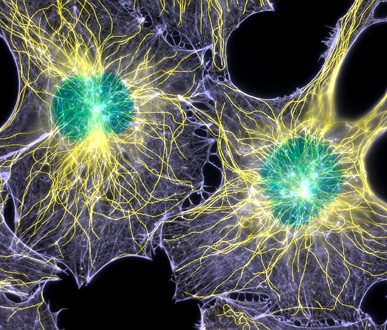
Mouse fibroblasts stained for actin (blue), microtubules (yellow), and nuclei (green). Image won first place at the 2003 Nikon Small World contest. (See larger)
"Fluoresence microscopy enables us to see specific structures or proteins inside a cell," Wittmann explains, "and the recent discovery of proteins that are fluorescent themselves allows us to observe the dynamics of specific proteins in living cells."
For a time, the downside of this technique was the difficulty in getting good images. "With standard film cameras, one would sometimes take three rolls of film and not get pictures that were any good," Wittmann recalls.
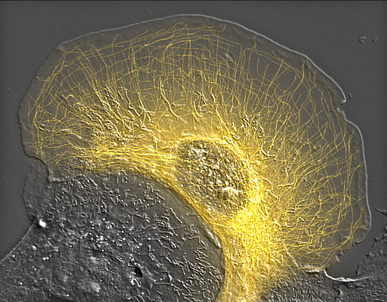
Fluorescent tubulin (yellow) overlaid over a differential interference contrast image of a live migrating kangaroo kidney epithelial cell. The cell is expressing an activated signaling protein, which gives it a flat, fried egg-like shape. (See larger)
Not anymore. Using high-quality digital cameras (that were actually first developed for astronomy), more powerful lenses and confocal techniques to eliminate out-of-focus light, the light microscope has become, in essence, a digital device, shooting many frames per second and capturing cellular events in striking detail. (Digital images also allow sophisticated computerized image analysis.)
A key difference, too — apart from the $250,000 price tag for the most advanced microscope setups — is that the cells being studied can now be living ones, not dead and fixed to a slide. "We can now quantify what is happening with different proteins and make conclusions about how certain processes in the cell are regulated in space and time, and what the functions of specific proteins are on a subcellular level," Wittmann explains.
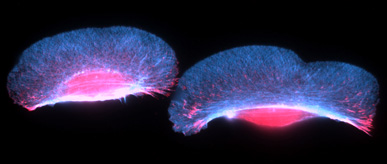
Migrating goldfish skin keratocytes stained for actin (blue) and adhesion sites (red). These cells that form the epithelium underneath fish scales are the fastest migrating vertebrate cells. (See larger)
Why is this important? We know that cells serve as a factory for many of the ingredients that sustain life and that these ingredients need to move from one location to another. Consider what happens to chromosomes, for example, as they are segregated correctly and moved into proper position prior to cell division. This is movement on a grand and precise scale. Indeed, without proper cell division, embryos die. And if the process were to stop in adults, many of our major organs would quickly shut down — taking us with them. But what's behind all this movement?
UCSF's Ron Vale, PhD, has been a pioneer in answering that question with his work on motor proteins. Motor proteins need the cell's version of a roadway to get where they're going. That's where Wittmann comes in. He studies microtubules, hollow protein rods that give shape and structure to a cell and that also shrink and grow in a random fashion (a non-equilibrium process discovered in the early '80s at UCSF by Tim Mitchison, PhD, and Marc Kirschner, PhD). Motor proteins move along microtubules to generate the force required to move chromosomes, for example.

Dividing kangaroo epithelial cell. Microtubules (green), DNA (blue), EB1, a protein that specifically associates with growing microtubule ends (yellow). (See larger)
In watching the elaborate dynamics of the microtubule cytoskeleton, Wittmann has become fascinated with a group of proteins that in cells only bind to growing ends of microtubules. "They look like little comets shooting through the cell," says Wittmann.
Knowing one step of the dance, though, does not explain the ballet, he admits. "The whole cellular protein network is an integrated system, so one of the conundrums in biology right now is how this network works together and what role individual elements play. Genome-wide sequencing has given us a parts list, but we still have a long way to go to figure out what each protein does."
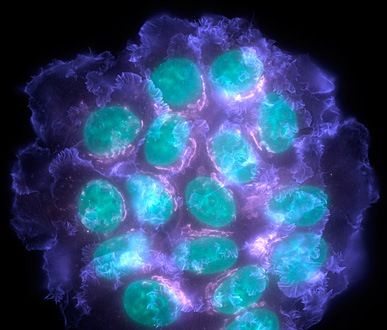
Growth factor stimulated human breast cancer cells stained for actin (blue), nuclei (green) and the Golgi apparatus (purple). (See larger)
Disturbing the genetic controls that regulate the accuracy of a cell's internal organization can disrupt normal cell behavior, such as directed cell migration. This disruption could, in turn, explain what happens when cancer cells spill from their original tumor and travel around the body — a process known as metastasis, which is the cause of most cancer deaths.
Correct cellular movements are also essential for normal development. For example, certain microtubule-motor proteins guide nerve cells along the correct migration routes in the brain from their birthplace in a neural fold to the cortex. "It can be catastrophic if they lose their way," Wittmann adds.
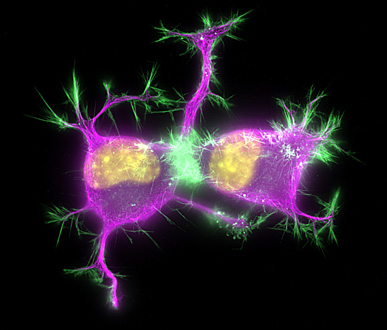
Differentiating neuroblastoma cells stained for microtubules (purple), actin (green). (See larger)
The same might be said for science in general, should the fashionable rush toward "translational" research, which packages grant proposals around their potential short-term impact on diseases and conditions, undercut such primary research as that surrounding cellular events. Wittmann refuses to be pessimistic. "Writing grants forces you to focus on the problem at hand and what your research is trying to contribute. I'd rather be trying to find a solution to a real problem anyway."
Then again, that's easy to say when the problems staring back at you from the microscope are manifested in dazzling and mysterious patterns. Maybe that's why Wittmann has taken up photography as a hobby.
Images/Torsten Wittman. Photo of Wittmann by Majed.
Alternative content
Related Links
- Torsten Wittmann, PhD, Cytoskeletal Dynamics and Cell Polarization
- UCSF Biomedical Sciences (BMS) Graduate Program
- Wittman Lab
- Department of Cell and Tissue Biology (CTB)
- UCSF School of Dentistry
- Cell biology
- Wikipedia
- Cell biology
- CELLS alive!